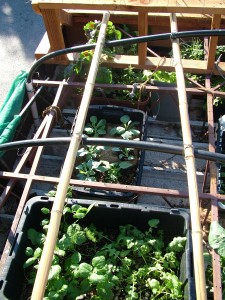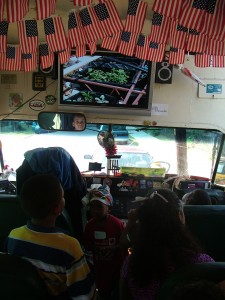Flying Sky Vegetables
Our friends Keith and George are starting a company called Sky Vegetables. They plan to grow vegetables on the roofs of supermarkets and sell the produce inside the same supermarkets. The food will travel zero miles from the field to the purchase point. It needs only travel downstairs. We have adapting this idea, erectile and are growing food on the roof of TheWhoFarmMobile, no rx even as we travel 60 miles per hour down the freeway across this big country. What could be better than setting up camp for the night and climbing just a few feet up and grabbing some spinach for a nice salad or carrots and cabbage for a stir fry? This is rooftop gardening to the extreme.
Making this garden work has certainly not been an easy task since there is not really a manual on mobile gardening but I have done my best with limited time and resources to at least grow a few things for our own consumption. If we can grow on the roof of a moving vehicle passing through various climatic zones, it proves that you can grow just about anywhere. Then certainly our next President can grow a few edible crops on the fertile soils outside of the White House where presidents in the past have grown food before.
When we acquired the Topsy Turvy bus from Ben Cohen (of Ben & Jerry’s,) we were not exactly sure how this experiment was going to work. As soon as we got to New York City from Vermont we started to scheme and made our first plan of action. The makers of the bus in Oakland, led by Tom Kennedy, had designed the roof to stand up to the elements, so it took quite a few hours to remove the hundreds of bolts and screws which held the fiberglass and plywood layers on top of the vehicle. We finally got everything off and below us lay a metal structure that looked perfect for container gardening.
We waterproofed the roof to keep our home inside the bus dry. We also installed a simple drainage system, consisting of drilled holes in the sides. Finally onto the fun part: planting our garden. Since our vehicle is already a bit top heavy, we chose to mix McEnroe Organic Farm’s potting mixture with GaiaSoil, a great lightweight medium used for green roofs and produced locally in New York. We also got some advice on waterless containers or “earthboxes.” Our container gardens were simpler in design, but we plan on enhancing our design in the near future.
Since we knew that survival for many crops would be near impossible on the roof, we selected resilient species and some of the hardiest varieties that folks could recommend to us. We knew that herbs such as rosemary and thyme and root crops would probably be fine, but we also were going for a bit of diversity so we planted a few varieties of squash, cucumbers, and other late summer veggies.
We were in a terrible rush to leave New York in order to make it to Slow Food Nation in San Francisco in time. So we did not have adequate time to build a permanent structure to protect our crops from the wind. We went with a quick fix, and threw some wire mesh screen on top of our containers to divert some of the wind and run with it and see what survived. The 60 mph headwinds throughout the journey and the 40 mph winds from the side in Wyoming did a number on our babies, but there were a few resilient survivors on our cross-country journey.
When we finally got to California where sunny skies reigned supreme, and with a better understanding of the roof dynamics, we had a bit of down time to do some more planting. Through the help of a number of friends and some cheap and donated materials from Urban Ore, a great recycling center in the East Bay, we were also able to set up a windscreen, which will hopefully do the plants a bit better. Another friend donated a large piece of bulletproof plexiglass which protects our plants further.
So on goes our adventure in mobile rooftop gardening and self-sufficiency on the road. Our garden has fared quite well down the California coast, across the Southwest, and into the Southeast. Keep on checking for more updates as we move into colder seasons.
By the way, there is no simple way up to the roof. But our bus came with a flat-screen tv. So we’ve tried a couple of times to do a live feed from the roof. It works alright, and kids love it, but it’s quite energy intensive, as the tv can only draw power from a generator.












